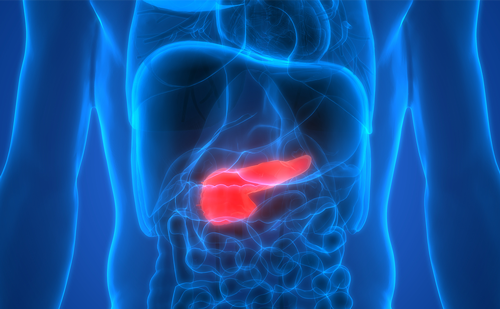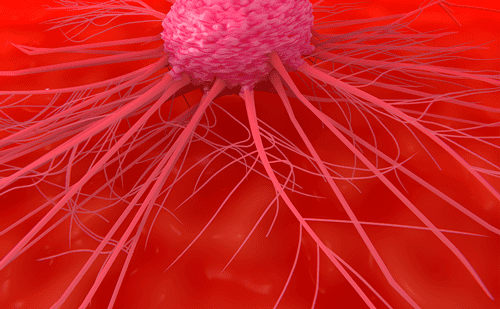In the recent revised classification of neuroendocrine tumors,6 the size of 2cm seems to be a crucial value over which carcinoid tumors start to exhibit malignant behavior. In other words, if resection is accomplished in time, no local recurrence might be encountered and a normal survival might be expected in the absence of metastatic disease.7 This article reports on a case of a primary pancreatic carcinoid tumor with unusual clinical presentation that induced the authors to describe some insights on these infrequent tumors.
Case Report
A 62-year-old woman was referred to the Hospital de La Source in February 1999 for intermittent epigastric pain and nausea, not always in relation to a meal. Clinical complaints of the patient began 12 months before observation. During this period, her blood tests, upper gastrointestinal (GI) endoscopy and abdominal computerized tomographic (CT) scan were found to be normal. Abdominal ultrasonography detected a 15mm hypoechoic lesion in the pancreas, and dilatation of proximal pancreatic duct. In the past, the patient had undergone appendectomy, subtotal hysterectomy, a surgical treatment of the left shoulder for traumatic lesion of ligaments, and surgical removal of a left benign breast nodule. During the previous year, the patient had suffered due to left leg phebitis complicated by minimal pulmonary embolism. She had a history of moderate smoking and alcohol intake for a long period of time and had been taking medicines (tranquillisers, vasodilators, antacids, analgesics).There was no history of weight loss. An abdominal examination did not evidence any abnormality.
Her hematological and biochemical parameters were unremarkable. Serum amylase and lipase levels were within normal range. Serum carcinoembryonic antigen (CEA) and cancer antigen (CA) 19-9 levels were not elevated. Serum gastrin, glucagon, insulin, and vasoactive intestinal polypeptide (VIP) levels were within normal limits. Urinary 5-hydroxyindoleacetic acid (5-HIAA) levels were normal,but serum serotonin level was elevated on three occasions (430, 365 and 370U/l respectively).
(The Netherlands) revealed an accumulation of the radioligand in the region of the suspected tumor, and confirmed the absence of metastatic disease.
In view of a localized pancreatic neoplasm, a surgical removal of the tumor was planned. At laparotomy, a pancreatic tumor was found by palpation on the left side of the portal vein.This was confirmed by intra-operative ultrasonography, which showed a hypo-echogenic, welldefined tumor, located between isthmus and corpus of the pancreas.The rest of the pancreas appeared normal.There was no evidence of metastasis in the liver and rest of the peritoneal cavity. Left spleno-pancreatectomy (distal pancreatectomy and splenectomy) with splenic, celiac,and hepatic lym-phadenectomy was accomplished. Gross examination of the cut specimen showed a tumor that was not dilated near but not compressing the pancreatic duct.There was no evident involvement of celiac, hepatic, or splenic lymph nodes. On microscopic examination the cell arrangement appeared compatible with a neuroendocrine tumor.The argentaffin reaction of Fontana–Masson was negative while the argyrophil reaction of Grimelius was positive. Immunohistochemistry demonstrated 100% tumor cell staining with chromogranine, anti-neuron-specific enolase (NSE), and anti-synaptophysine antibodies. Staining with antibodies for gastrin,VIP, glucagon, and insulin were negative. Tumor cells displayed strong immuno-reactivity to anti-serotonin antibodies.
The above findings on pathological examination were conclusive of a diagnosis of a benign or low-grade malignant (functioning, well differentiated, nonangioinvasive) neuroendocrine embryonal carcinoma (EC) cell (carcinoid) tumor of the pancreas in the Capella classification.6
One year after her operation, the patient was free of symptoms, her serum levels of serotonin were within normal limits, and she had no signs of distant metastases.
Discussion
Carcinoid tumors can no longer be considered a rare disease, with reports being published in medical literature on large numbers of patients.2,8 Their incidence varies from 2.1 per 100,000 population per year2 to 8.4 per 100,000 population per year.9 It is likely that a significant percentage of carcinoid tumors remain asymptomatic and undetected during the lifetime of an individual. According to their embryological origin, these tumors are classified into fore-gut carcinoid (respiratory tract, pancreas, stomach, proximal duodenum), mid-gut carcinoid (jejunum, ileum, appendix, Meckel’s diverticulum, ascending colon), and hind-gut (transverse and descending colon, rectum) carcinoid tumors.10 This distinction may be useful, as carcinoid tumors from different areas have different clinical manifestations, humoral products, and immuno-histochemical features. Most of the classic syndromes relating to the overproduction of gastrointestinal and pancreatic hormones originate from fore-gut carcinoid tumors. Most of the cases are thought to secrete such low amounts of hormones that it causes no clinical symptoms, and hormonal, hypersecretory states cannot be detected.
In the present report, only a slight increase in serum serotonin levels occurred without any increase in urinary levels of its metabolites (5-HIAA).This is consistent with the benign behavior in the patient in the study, as the tumors become symptomatic only when hepatic metastases occur, which manifests as classic carcinoid syndrome. It is not clear whether such behavior can be attributed to a benign tumor alone or to an early-stage malignant tumor too. In classic histological terminology, carcinoid lesions are widely regarded as malignant neoplasms.10,12 However, there are no precise histological criteria to distinguish benign from malignant carcinoid or the carcinoid with metastatic potential.The possibility of a cure in these patients is directly related to an early diagnosis. Unfortunately, as these lesions are asymptomatic or have non-specific clinical manifestations, as in this case, the diagnosis is often delayed. The most frequent symptoms associated with pancreatic carcinoid tumors are abdominal pain (66%) and diarrhea (52%), related to intestinal hypermotility.7 In some reports,13–16 pancreatitis seemed to be the consequence of the ductal obstruction by the tumor, while in one report7 a recurrent pancreatitis was present for more than 10 years before the onset of the first symptoms attributed to a carcinoid. The pathogenesis of the abdominal pain in the patient in this study is difficult to ascertain, as no associated pancreatitis, pancreatic duct dilatation, or neural invasion were detected at the pathological examination. It was suspected that symptoms in the patient might be related to functional or transient events in the intestine or in the pancreatic duct due to episodic humoral or enzymatic secretions by the tumor. This is supported by the intermittent nature of the abdominal pain and the ultrasonographic finding of pancreatic duct dilatation at the first instance, which was not detected on subsequent examinations.
Endoscopic ultrasonography is a useful test for detecting and precisely localizing a tumor within the pancreas.17 Somatostatin receptor scintigraphy with 111Indiumlabeled pentreotide is useful in confirming the neuroendocrine mass and excluding distant metastases.18 Both these investigations could successfully diagnose and localize the carcinoid tumor in the patient. More extensive application of these two investigations in clinical practice may result in early detection of neuroendocrine tumors even in patients with no or only non-specific complaints.
Meanwhile, one should be aware of the existence of pancreatic carcinoid tumors. For the tumors limited to the pancreas and with no evidence of distant metastases, a radical resection with lymphadenectomy can result in a precise histological characterization of tumor and detection of occult lymph node metastases.19 Resection at this stage may be curative.







